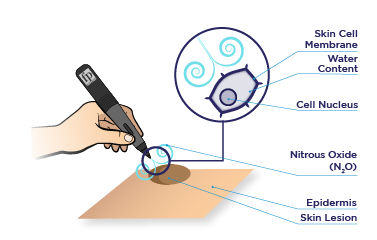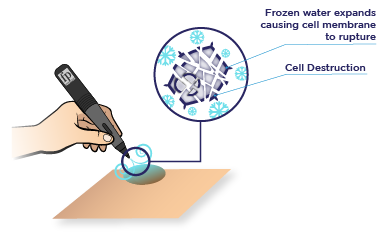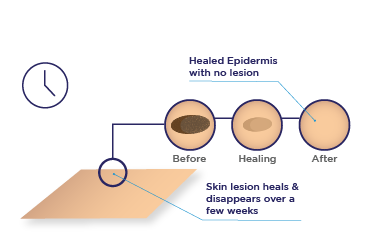
NO ANESTHESIA. NO DOWNTIME. NO SCARS.
+ SAFE: Non-invasive and accurate treatment significantly reduces risks and complications.
+ FAST: Most treatments take less than a minute!
+ COMFORTABLE: No anesthesia required. Patients report minimal discomfort.
+ NO DOWNTIME: Patients resume their daily activities immediately after treatment.
+ NO SCARS: As opposed to other invasive treatments, FreezPen does not leave any permanent scars on the skin.
TREATS COMMON* LESIONS ON THE FACE AND BODY
- Dark spots
- Age spots
- Skin tags
- Warts
- Moles
- Fibromas
- Keratosis
- Angiomas
- Milia
- Molluscum
- And more…
*non-malignant
FreezPen erases skin lesions and defects safely, precisely and comfortably, with cryotherapy.

1. Rapidly and precisely freeze the unwanted lesion.

2. Water in the lesion cells will freeze, expand and rupture the cell membrane.

3. Targeted lesion cells are destroyed, and the lesion disappears after healing.
After the treatment, the lesion will gradually fall off, new skin forms and the area returns to its original colour.
Frequently Asked Questions
FreezPen Cryotherapy Technology
Cryotherapy is a procedure that utilizes extreme cold to destroy unwanted tissue. The process is called “Cryo-necrosis” – tissue destruction by rapid freezing.
The rapid freezing rate of the FreezPen is based on The Joule-Thomson (JT) effect. This is a thermodynamic process that occurs when a fluid expands from high pressure to low pressure. FreezPen cryotherapy utilizes a cryogenic gas called Nitrous Oxide (N2O) which is compressed at 725 PSI (very high pressure). When nitrous oxide is released from the FreezPen as a jet of gas, it expands at -89°C and immediately freezes the affected lesion.
The mechanism of action behind FreezPen is simple and highly effective: application of extreme cold in a rapid freezing rate in order to freeze and destroy the lesion. The unique applicator’s tip creates a focused, high-pressure jet of extremely cold nitrous oxide gas that is targeted at the lesion. The temperature of the lesion drops to -89°C within seconds, causing the water inside the cells to freeze, expand and rupture the membranes of cells. As a result, the cells that form the lesion are destroyed and eliminated by the body over time, to allow a new healthy skin to grow in the same location.
No, nitrous oxide (N₂O) is a safer alternative to liquid nitrogen (N₂) and yields similar results.
Cells destruction in all benign growths is achieved at -60°C. Both liquid nitrogen (-195°C) and nitrous oxide (-89°C) drop in-tissue temperatures to -60°C and lower within seconds. The excessive power of liquid nitrogen is more likely to cause unwanted collateral damage to surrounding healthy tissue. Liquid nitrogen increases the risk of pigmentation and other adverse effects, while FreezPen’s nitrous oxide allows high-precision treatments targeting only the lesion itself. This is a significant advantage when treating small lesions such as milia, molluscum contagiosum, small warts and moles, or when lesions are found around delicate areas.
FreezPen cryotherapy is a non-invasive treatment that involves minimal discomfort and does not require anesthesia or stitches. FreezPen treatment has no downtime and it significantly reduces the risk of scars and other complications. Treatment is quick and does not require special post-op care.
FreezPen Cryotherapy Treatment
FreezPen treats all types of common non-malignant skin lesions: warts, dark spots, liver/age spots, skin tags, moles, keratosis, angiomas, fibromas, milia, molluscum contagiosum and more. Please note that any types of malignant or suspicious growths need to be treated by a certified dermatologist.
Your lesion is expected to fall off 2-4 weeks after the treatment. Some lesions are more persistent and may take longer to disappear
The treatment is comfortable and doesn’t hurt. It feels like a light pinch. There is no need for local anesthesia.
Most lesions require one treatment. Large lesions, such as warts, may require 1-2 follow
up treatments.
Immediately after. FreezPen treatments involve zero downtime.
FreezPen cryotherapy is the safest modality for the removal of unwanted skin growths. Since FreezPen treatments are non-invasive and precise, the risk of scars and infections is significantly diminished when compared to other invasive treatments.
As many as you like. There is no limit on the number of lesions per session.
Yes, children are most commonly treated for warts and Molluscum Contagiosum. FreezPen cryotherapy is a tolerable modality suitable for both children and adults.
FreezPen treatment usually takes no more than a few minutes. The duration of the treatment depends on the number of treated lesions, the number of freeze-thaw cycles and the duration of freezing.
New skin growths (especially moles) are potentially malignant and need to be evaluated by a dermatologist first. Only stable lesions that are not evolving over time are suitable for cryotherapy treatments. Consult with a certified physician to make sure your new mole is a non-malignant growth before removing it with FreezPen.
Yes, FreezPen treatment is safe for everybody.
Generally, there is no post-treatment care regime and you may resume your daily activities immediately after the treatment. We do advise patients to apply healing ointments (such as Aquaphor) on the area of the treatment to speed up the healing process.
Although FreezPen cryotherapy is the safest treatment today for the removal of skin lesions, a few rare side effects may still occur. These side effects include:
- Pigmentation – Temporary pigmentation is rare but possible because melanocytes are more susceptible to sub-zero temperatures. FreezPen minimizes the risk of collateral damage to healthy skin tissue, so the risk of pigmentation is minimized as well.
- Blisters – temporary blisters may appear in the lesion area due to fluids that are released from destroyed lesion cells.
- Hair loss – like melanocytes, hair follicles are more susceptible to sub-zero temperatures. Hair follicles in the treated area are more likely to be affected, thus hair may not grow back in the area of the lesion after cryotherapy.